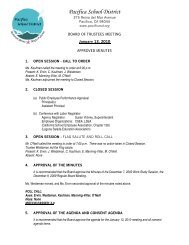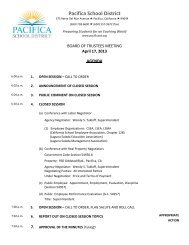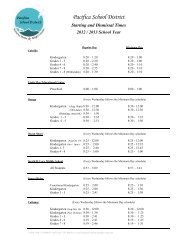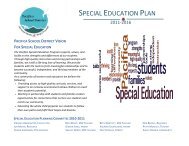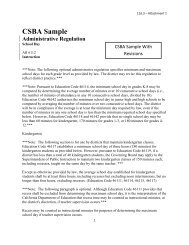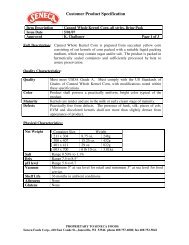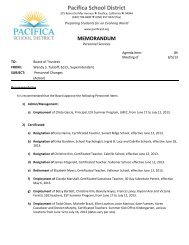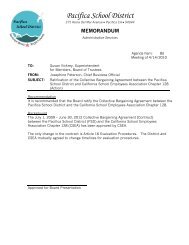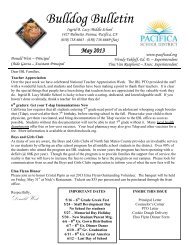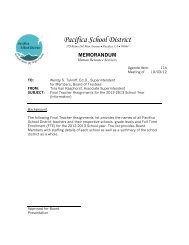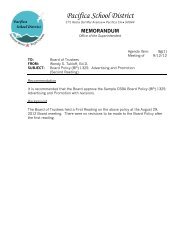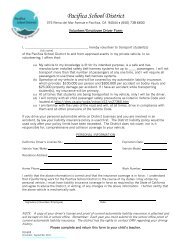Library/Media/Technology Plan at a Glance - Pacifica School District
Library/Media/Technology Plan at a Glance - Pacifica School District
Library/Media/Technology Plan at a Glance - Pacifica School District
Create successful ePaper yourself
Turn your PDF publications into a flip-book with our unique Google optimized e-Paper software.
PACIFICA SCHOOL DISTRICT VISION FOR<br />
LIBRARIES/MEDIA/TECHNOLOGY<br />
We envision a community th<strong>at</strong> supports students in their curiositydriven<br />
use of library, media, and technology resources in order th<strong>at</strong><br />
students acquire, evalu<strong>at</strong>e, demonstr<strong>at</strong>e, and communic<strong>at</strong>e<br />
knowledge and 21 st Century capacities. In the process, our students<br />
develop into successful, adaptive, global citizens.<br />
COMMITTEE WORKING GROUP FACILITATORS<br />
CATHY ALDERSON, TEACHER ANGELA KOBLITZ, LIBRARY/MEDIA CLERK CATHY ALDERSON STEVE KESEL, 21 ST CENTURY ED FACILITATOR<br />
SUE BECKMEYER, PARAPROFESSIONAL MICHELE SULLIVAN, TEACHER SUE BECKMEYER NELSON SENDINO, NETWORK ADMINISTRATOR<br />
MEGHANN ELSBERND, TEACHER SHARONN WILSON, TEACHER<br />
ANNETTE HOLTHAUS, COMPUTER LAB AIDE<br />
PACIFICA SCHOOL DISTRICT<br />
<strong>Library</strong>/<strong>Media</strong>/<strong>Technology</strong> <strong>Plan</strong><br />
<strong>at</strong> a <strong>Glance</strong><br />
<br />
2012-2014 (2 YEARS)<br />
See full text version of the <strong>Library</strong>/<strong>Media</strong>/<strong>Technology</strong> <strong>Plan</strong> for in depth descriptions and details.
PACIFICA SCHOOL DISTRICT<br />
PRINCIPLES FOR LIBRARIES/MEDIA/TECHNOLOGY<br />
Libraries, <strong>Media</strong>, and <strong>Technology</strong> Are Interrel<strong>at</strong>ed<br />
Libraries, <strong>Media</strong>, and <strong>Technology</strong> in the 21 st Century are highly inter-rel<strong>at</strong>ed and can no longer be thought of as separ<strong>at</strong>e entities.<br />
Libraries/media centers are no longer merely houses of print media but r<strong>at</strong>her are portals for obtaining inform<strong>at</strong>ion th<strong>at</strong> is no longer<br />
confined by the walls of a building. <strong>Media</strong>, the means of communic<strong>at</strong>ion, are increasingly involving technology. So we best serve our<br />
children when technology is as well integr<strong>at</strong>ed into the learning process as it is integr<strong>at</strong>ed into the rest of their world.<br />
<strong>Technology</strong> Is a Powerful Tool for Learning Academic Content and 21 st Century Capacities<br />
The purpose of technology in educ<strong>at</strong>ion is to engage students and staff in rich learning experiences th<strong>at</strong> both enhance the learning of<br />
academic content and build 21 st Century capacities. (See Appendix C: <strong>Pacifica</strong> <strong>School</strong> <strong>District</strong>’s 21 st Century Educ<strong>at</strong>ion Framework).<br />
Our Children and Staff Need Abundant Access<br />
In order to develop the capacities listed in <strong>Pacifica</strong> <strong>School</strong> <strong>District</strong>’s 21 st Century Educ<strong>at</strong>ion Framework, students and educ<strong>at</strong>ors need to be<br />
ensured abundant access to inform<strong>at</strong>ion, media resources, and appropri<strong>at</strong>e, supportive technology.<br />
The Most Important <strong>Technology</strong> Skill We Can Teach Is Adapt<strong>at</strong>ion<br />
<strong>Technology</strong> is developing <strong>at</strong> such a rapid pace th<strong>at</strong> it will no longer serve our students to merely teach isol<strong>at</strong>ed technology skills th<strong>at</strong> will<br />
soon become obsolete. R<strong>at</strong>her, as we embed technology into the process of learning academic content, we foster in our students and<br />
staff a familiarity of current technologies and nurture an enthusiasm for learning new and evolving technologies.<br />
Libraries Are Learning Commons<br />
The way people learn and work is quickly evolving in the Age of Connectedness, and libraries/media centers are no longer functioning as<br />
places where individuals independently g<strong>at</strong>her inform<strong>at</strong>ion in silence. R<strong>at</strong>her, libraries/media centers are becoming “learning commons”<br />
(See, for example, the library websites for University of Illinois, University of Massachusetts, and York University) where members of<br />
virtual communities g<strong>at</strong>her in the real world to enhance learning by exchanging ideas, engaging in dialogue, and sharing resources.<br />
We Emphasize Digital Citizenship<br />
The digital community is merely an extension of the global community in which we live. To the extent th<strong>at</strong> we teach our children to<br />
become responsible, conscientious, and analytical digital citizens, we also teach them to become concerned, adaptive global citizens.<br />
(See Appendix A: N<strong>at</strong>ional Educ<strong>at</strong>ion <strong>Technology</strong> Standards- Students, Standard 5; Teachers, Standard 4; Administr<strong>at</strong>ors, Standard 5).
STRATEGIC AREAS OF FOCUS FOR LIBRARIES/MEDIA/TECHNOLOGY:<br />
The table below provides a summary of nine str<strong>at</strong>egic areas of focus identified by the <strong>Library</strong>/<strong>Media</strong>/<strong>Technology</strong> (L/M/T) Committee as<br />
essential for equipping students acquire, evalu<strong>at</strong>e, demonstr<strong>at</strong>e, and communic<strong>at</strong>e knowledge and 21 st Century capacities. These areas of<br />
focus engage libraries, media, and technology in promoting rigorous, differenti<strong>at</strong>ed and holistic learning. Inspired by the N<strong>at</strong>ional Educ<strong>at</strong>ion<br />
<strong>Technology</strong> Standards and the California Model <strong>School</strong> <strong>Library</strong> Standards, they emphasize using libraries, media, and technology to support<br />
content learning and character development. Finally, for increased coherence, these focus areas reflect collabor<strong>at</strong>ion with the Str<strong>at</strong>egic<br />
<strong>Plan</strong>ning Committee and the other PSD curriculum and support plan committees.<br />
I.A. – Promote the<br />
effective use of technology<br />
in the learning process<br />
PACIFICA SCHOOL DISTRICT<br />
I.B. - <strong>Library</strong>/media<br />
centers support the<br />
learning of academic<br />
content<br />
I. LEARNING THAT IS RIGOROUS<br />
I.C. – Human<br />
resources support<br />
the L/M/T programs<br />
I.D. - Ensure universal<br />
access to a robust<br />
technological<br />
infrastructure<br />
II. LEARNING THAT IS DIFFERENTIATED<br />
I.E. – Students<br />
develop inform<strong>at</strong>ion<br />
literacy<br />
II.A. - Response to instruction and intervention/learner-oriented instruction II.B. - Self-directed, collabor<strong>at</strong>ive learning<br />
III.A. - Digital citizenship and community well being<br />
III. LEARNING THAT IS HOLISTIC<br />
I.F. - <strong>Technology</strong><br />
enhances form<strong>at</strong>ive<br />
and summ<strong>at</strong>ive<br />
assessment
PACIFICA SCHOOL DISTRICT<br />
2012 – 2013; 2013- 2014 LIBRARIES/MEDIA/TECHNOLOGY<br />
STANDARDS: Common Core S<strong>at</strong>e Standards (CCSS), N<strong>at</strong>ional Educ<strong>at</strong>ion <strong>Technology</strong> Standards (NETS), California Model <strong>School</strong> <strong>Library</strong> Standards (CMSLS)<br />
TIMELINE/KEY PEOPLE<br />
(NUMBERS CORRESPOND TO ACTIVITIES)<br />
8/2012 - ongoing<br />
Teachers (#1, 2)<br />
21 st Century Educ<strong>at</strong>ion Facilit<strong>at</strong>or (#1-<br />
7,9,10) M<strong>at</strong>h and Literacy Facilit<strong>at</strong>ors<br />
(#2,3,5,7,9,10)<br />
Network Administr<strong>at</strong>or (#5,9)<br />
SMCOE <strong>School</strong> <strong>Library</strong> Services<br />
Coordin<strong>at</strong>or and the <strong>School</strong><br />
<strong>Library</strong>/<strong>Media</strong> Coordin<strong>at</strong>ors Group<br />
(#7,8)<br />
L/M/T Committee (#6)<br />
Working groups (#1, 4)<br />
8/ 2012 – ongoing<br />
21 st Century Educ<strong>at</strong>ion Facilit<strong>at</strong>or<br />
<strong>School</strong> administr<strong>at</strong>ors<br />
Counselors<br />
8/ 2012 ongoing<br />
<strong>District</strong> administr<strong>at</strong>ion (Facilit<strong>at</strong>ing #1)<br />
21 st Century Educ<strong>at</strong>ion Facilit<strong>at</strong>or (#3,<br />
4)<br />
M<strong>at</strong>h and Literacy Facilit<strong>at</strong>ors (#4)<br />
Network Administr<strong>at</strong>or (#2-5)<br />
PTO/PTA and site-based staff (#2)<br />
8/ 2012 ongoing<br />
Literacy Coach, <strong>Pacifica</strong> <strong>School</strong><br />
Volunteers (#1)<br />
Principals & library staff (#2, 3)<br />
Associ<strong>at</strong>e Superintendent (#2)<br />
ACTIVITIES<br />
21 st Century Learning: Instructional Support<br />
1. Finish developing and introduce a technology scope and sequence<br />
2. Provide 21 st Century Educ<strong>at</strong>ion Experiences (Grades K-8)<br />
3. Continue to integr<strong>at</strong>e the use of technology into content area coaching and<br />
professional development<br />
4. Identify key 21 st Century capacities for the next gener<strong>at</strong>ion of report cards<br />
5. Continue to provide electronic resources to staff and students<br />
6. Investig<strong>at</strong>e and pilot electronic portfolios<br />
7. Continue to promote effective use of the Internet for research<br />
8. Support the implement<strong>at</strong>ion of the California Model <strong>Library</strong> Standards<br />
9. Continue to promote effective, systemic use of cloud-based instruction and<br />
assessment tools (Google Apps for Educ<strong>at</strong>ion, Synergy, D<strong>at</strong>aDirector, etc.)<br />
10. Students further utilize software to support differenti<strong>at</strong>ed learning<br />
21 st Century Learning: Responsible Digital Citizenship<br />
Begin to implement a digital citizenship initi<strong>at</strong>ive for socially responsible, ethical &<br />
legal use of technology<br />
21 st Century Learning: Key People and Infrastructure<br />
1. Continue to identify and/or seek funding to provide<br />
library paraprofessionals<br />
<strong>at</strong> least two certific<strong>at</strong>ed librarians to serve sites<br />
library/media support beyond the school day<br />
instructional technology technician<br />
more technology tools for students<br />
2. Support Mouse Squad<br />
3. Maintain a <strong>Library</strong>/<strong>Media</strong>/<strong>Technology</strong> Committee to monitor the L/M/T plan,<br />
make recommend<strong>at</strong>ions about technology purchases, and collabor<strong>at</strong>e with the<br />
<strong>School</strong> <strong>Library</strong> Coordin<strong>at</strong>ors’ Group<br />
4. Maintain <strong>District</strong> software (Synergy, Follett, etc.); pilot/implement new software<br />
as appropri<strong>at</strong>e (Edmodo, D<strong>at</strong>a Dashboard, Google Apps for Educ<strong>at</strong>ion, etc.)<br />
5. Further ensure robust Internet access in every learning and work space<br />
<strong>Library</strong> Support of Common Core St<strong>at</strong>e Standards (English Language Arts)<br />
and Balanced Literacy<br />
1. Continue to facilit<strong>at</strong>e a resident readers program<br />
2. Maintain professional libraries for educ<strong>at</strong>ors<br />
3. Fe<strong>at</strong>ure recommend books<br />
MEASUREMENT/<br />
EVIDENCE<br />
Committee products/tools developed<br />
(#1, 4, 5, 6)<br />
Artifacts: PD agendas and sign-ins (#1-4,<br />
6-10)<br />
PSD website traffic reports (#5),<br />
student/teacher log-in d<strong>at</strong>a (#9,10)<br />
Standardized test results (#9,10)<br />
Student work (#6, 8-10)<br />
Board adoption of digital citizenship<br />
initi<strong>at</strong>ive<br />
E-r<strong>at</strong>e digital citizenship document<strong>at</strong>ion<br />
<strong>Technology</strong> Acceptable Use Policy<br />
Artifacts: Meeting agendas/minutes,<br />
grant applic<strong>at</strong>ions (#1-5), new/revised<br />
job descriptions (#1)<br />
<strong>District</strong> budget, purchase orders (#4-5)<br />
Number of completed work orders (#5)<br />
Artifacts: Class sign-up records (#1),<br />
<strong>Library</strong> Coordin<strong>at</strong>ors’ Group minutes<br />
(#2,3), purchase orders (#3)<br />
<strong>Library</strong> books (#2)<br />
FUNDING<br />
SOURCE(S)<br />
PEF<br />
PTO/PTA<br />
C<strong>at</strong>egorical<br />
Parcel Tax<br />
General<br />
SVCF<br />
Special Ed<br />
General<br />
PEF<br />
Parcel Tax<br />
PTO/PTA<br />
General<br />
C<strong>at</strong>egorical<br />
PEF<br />
Special Ed<br />
ARRA<br />
C<strong>at</strong>egorical<br />
Textbook<br />
Parcel Tax




